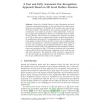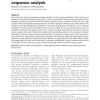261 search results - page 5 / 53 » Using Local Alignments for Relation Recognition |
ACIVS
2008
Springer
13 years 9 months ago
2008
Springer
Sensitivity of global features to pose, illumination and scale variations encouraged researchers to use local features for object representation and recognition. Availability of 3D...
ICRA
2006
IEEE
14 years 1 months ago
2006
IEEE
— Mobile robots do not adequately represent the objects in their environment; this weakness hinders a robot’s ability to utilize past experience. In this paper, we describe a s...
FGR
2006
IEEE
14 years 1 months ago
2006
IEEE
We present a novel tracking algorithm that uses dynamic programming to determine the path of target objects and that is able to track an arbitrary number of different objects. The...
BMCBI
2008
13 years 7 months ago
2008
Background: Nonnegative matrix factorization (NMF) is a feature extraction method that has the property of intuitive part-based representation of the original features. This uniqu...
BIB
2006
13 years 7 months ago
2006
One of the major goals of computational sequence analysis is to find sequence similarities, which could serve as evidence of structural and functional conservation, as well as of ...


